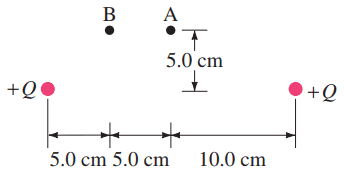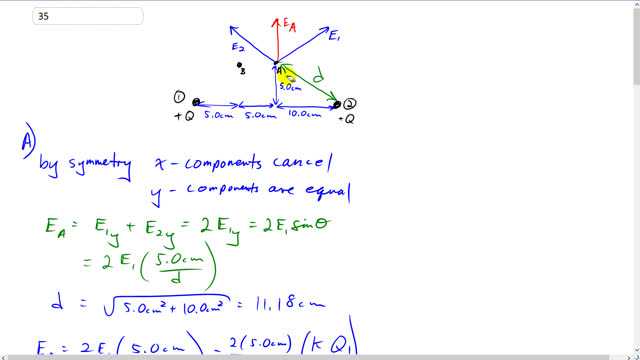
Use Coulomb’s law to determine the magnitude and direction of the electric field at points A and B in Fig. 16–60 due to the two positive charges shown. Are your results consistent with Fig. 16–32b?


In order to watch this solution you need to have a subscription.
This is Giancoli Answers with Mr. Dychko. So let's find the electric field at this point A which horizontally is midway between the charges one and two. We can see from symmetry that this electric field due to charge one and the electric field due to charge two, pointing this way, are gonna have their x components cancel because they're on the same angle. And here's the x component of electric field one. And here's the x component of electric field two. And there's gonna be the same angle theta here which is gonna be equal to this angle here because you know we have two parallel lines and their transverse between them and so that makes these two angles corresponding and corresponding angles are equal and the same thing can be said for this angle here, theta and so, E one x is E one times cosine of theta and E one is going to equal E two because they're at the same distance from this point A and both charges of the same magnitude So E one equals E two and the theta equals theta. And so you know I guess if I wanted to get all thorough or better I could say E two x equals E two times Cos theta and since E one equals E two, E one x equals E two x. Okay. x components cancel. That's nice. So all we have to do here is calculate the y component of one of the electric field and multiply by two and we'll get our answer in the end it will be directed straight up. So the total electric field at Point A is the y component of electric field due to point one, charge one and the y component of the electric field due to charge two These y components will be equal. So, let's just take two times one of them and so it's going to be two times electric field due to charge one times sine theta. So this vertical component here. This is E one y component that is E one times sine theta because it's the opposite leg of this triangle here and we'll take that times two because this E two y component'll have the same magnitude so this is multiplied one of them by two to get our answer for the total electric field there. And so sine theta is gonna be the opposite divided by the hypotenuse. Now we can use this triangle if we like and that'll be five centimeters for the vertical divided by this distance here which we'll call distance d from the point to point A, from the charge to point A. And we don't even need to figure out the degrees we can just take this ratio and then that'll be what we need. Five divided by the hypotenuse will be the side of this angle and this angle is the same so sine of that will be the same as well. So we need to figure out what d is then and d is going to be using Pythagoras, the square root of five centimeter squared plus ten centimeters squared to give 11.18 centimeters. And so electric field at point A is two times E one times five over 11.18. And E one is k Q one over d… and squared I should say. And so that's two times five centimeters over 11.18 centimeters since the units are the same we’ll cancel. We don't need to convert them into meters and we'll multiply that by 8.988 times ten to the nine newtons meters per squared per coulomb squared times the charge of 4.7 times ten to the minus six coulombs divided by 11.18 times ten to the minus two meters squared. We do have to convert this into meters by the way because there's no units on top that are going to cancel with it. When in doubt convert units to M.K.S, meters, kilogram, seconds and so on. So we end up with 3.0 times ten to the six newtons per coulombs directed straight up. And then for point B This one's a bit more complicated because we can't use symmetry to just make some x components disappear. In this case the x components are not equal because Point B is not midway between the charges. The net electric field is going to have an x component equal to the sum of these x components and it's going to have a y component equal to the sum of these two y components put together. And we need to know the distances from the charges to the point B. So the distance d one from charge one to Point B is square root of five centimeters squared plus the vertical five centimeters squared and square root that sum and you get a 7.0711 centimeters and d two the distance from charge two to the point B is gonna be the square root of the the five centimeter vertical squared plus 15 centimeters horizontal squared. And so we're just using Pythagoras to find the hypotenuse of this triangle here. And so that's one thing we need to know. And then let's algebraically say what I said before that the x component of the net resultant electric field, the point B is the x component of the field due to charge one and it’s gonna be minus electric field of the x component of the electric field due to charge two and I put a minus here because the x component of E two is to the left. And so that's the negative direction. You know, we have positives up into the right. And so this is E one times Cos theta one. That's what E one x is. So, E one x is the adjacent leg of this triangle and so we'll take the hypotenuse E one and multiply by cosine of theta one to get it and then E two x is E two hypotenuse times cosine of theta two and the cosine of theta one is gonna be the adjacent five centimeters divided by the hypotenuse of 7.0711 centimeters. So it's a five over d one. And since this angle here equals this angle here… the cosine of this angle here's going to be the same because it's the same angle so no need to figure out the number of degrees here and plug in cosine of that many degrees in a calculator instead we can just use the ratio of side lengths here because that's what cosine means. Take the adjacent divided by the hypotenuse. And so same with theta two, we have an adjacent of 15 centimeters divided by a hypotenuse of 15.811 centimeters And that replaces Cos theta two. Then we'll plug in E one is k Q over d one squared and E two is k q over d two squared both charges have the same magnitude Q and then we could factor out the k Q and its 8.988 times ten to the nine newtons meters squared per coulomb squared times the charge of 4.7 times ten to the minus six coulombs and then multiply by five over 7.0711 centimeters. And it times by one over 7.0711 times ten to the minus two meters squared. And I guess the way I've done it might be slightly confusing with units because you don't have to convert the 7.0 centimeters here to meters but you do have to convert it here because it's nothing on top to cancel it away so you better end up with meters kilogram seconds, M.K.S units. Unless they just cancel away as the case’s here then on the second term it's minus 15 centimeters over 15.811 centimeters times one over 15.811 times ten to the minus two meters squared. And that gives us an x component of 4.3709 times ten to the six newtons per coulomb. It's positive so that means it's directed to the right and that does meet our expectations always do the reality check in your answers. If we'd had a negative number we would have known that something had gone awry because since Point B is closer to the point charged one, we expect whatever charge one's direction to be to win. So charge one is pointing to the right with his x component and it should be doing so with greater strength than charged to is since Point B is closer to charge one. Length of the y component, it’s E one sine theta one plus E two sine theta two, they are both positive because they both directed upwards. E one times sine theta one is five over… the vertical five over the hypotenuse which works out to the same as the cosine of theta one. And in sine theta two, is the opposite five centimeters divided by 15 centimeters. And similar process to before factoring out the kQ from both of these electric field terms and then leaving behind the one over d one squared in this case of E one and one of d two squared in the case of E two and so we end up with 8.988 times ten to the nine newton meters squared per coulomb squared times 4.7 times ten to the minus six coulombs times five over 7.0711 centimeters times one over 7.0711 times ten to the minus two meters squared plus five over 15.811 times one over 15.811 times ten to the minus two meters squared. And this gives 6.5084 times ten to the six newtons per coulombs for the y component of the resultant at point B. Then use Pythagoras to combine these into the resultant magnitude and so the resulting magnitude with the square root of the squares of each of the components X and Y. So the x components is to the right and that’s 4.7309 times ten to the six newtons per Coulombs square that and add 6.5084 times ten to the six newtons per coulomb squared and square root that sum and you get 7.8399 times ten to the six newtons per coulomb and then the angle theta is gonna be the inverse tangent of the y component over the x component. So it's the inverse tangent of 6.5084 divided by 4.3709, didn't even need to write the times ten to the sixth since we're going to cancel it anyway. And this works out to 56.1155 degrees and so our answer is, the electric field at point B is 7.8 times ten to the six newtons per coulomb, 56 degrees above the positive x axis and technically we didn't have to say that if we just write 56 degrees the presumption is that it's in standard position and standard position is always measured counter-clockwise with respect to the positive x axis as we've shown in our diagram. There we go.
I got to the same answer, but the book disagrees. There are solutions in the book for odd-numbered problems, so solution for problem 35 is shown. It says the magnitude of E is 7.8*10^7, so it's off by 1 order of magnitude. Is this an error in the book?